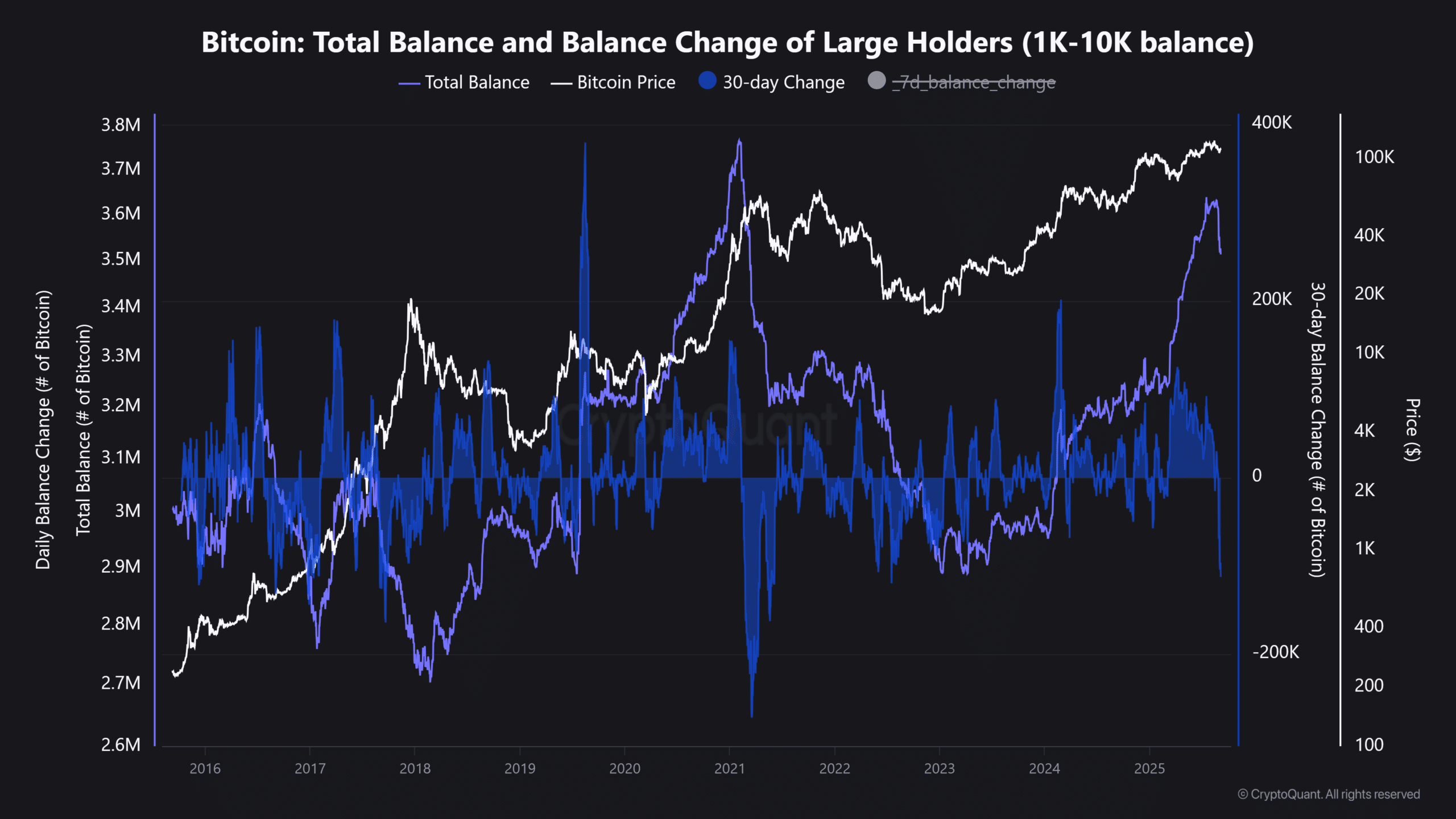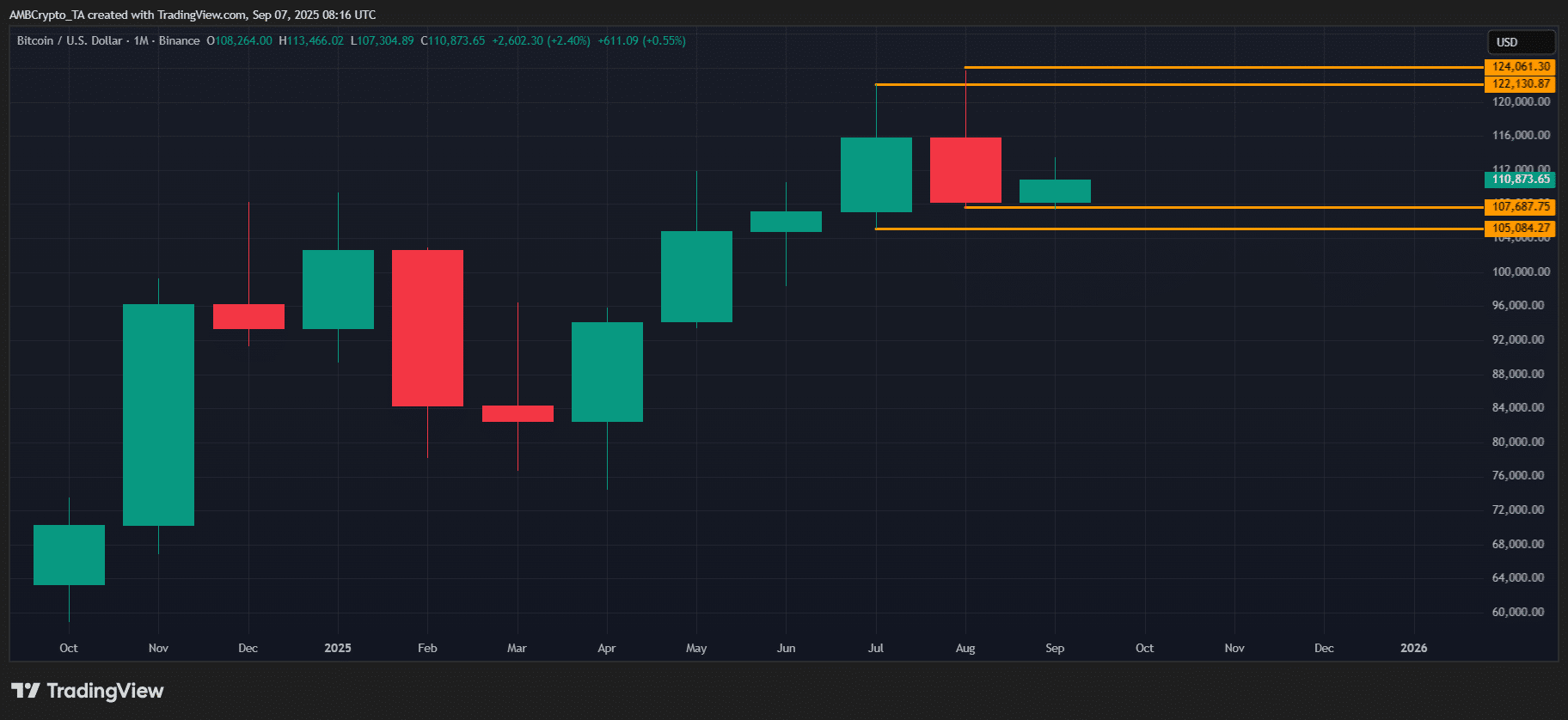Bitcoin whale reserve drop in August 2025 shows major holders in the 1k–10k BTC cohort realized gains, triggering a ~112k BTC one‑month net outflow; that shift increased short‑term distribution risk and raises the odds of extended consolidation for BTC near $110k.
-
Whales (1k–10k BTC) unloaded ~112k BTC in one month — largest 30‑day drop since 2022.
-
The 1k–10k cohort grew to 3.62M BTC through April–August before the August distribution.
-
August closed 6.5% down from the $115.8k open, marking the worst monthly close since the post‑Liberation FUD period.
Bitcoin whale reserve drop signals record outflows and elevated consolidation risk for BTC near $110k — read analysis, data and actionable takeaways.
What caused the Bitcoin whale reserve drop in August 2025?
Bitcoin whale reserve drop occurred as large holders in the 1k–10k BTC cohort realized profits after a 50% rally from April’s ~$82k base, producing a 30‑day net distribution of roughly ‑112.8k BTC. On‑chain data from CryptoQuant shows this is the steepest one‑month net outflow for this cohort since 2022.
How much did whales unload and which cohort moved supply?
On‑chain metrics show whales holding 1k–10k BTC absorbed ~270k BTC across April–August, growing to 3.62 million BTC by mid‑August. The cohort then shifted supply aggressively: the 30‑day change printed at ‑112.8k BTC, the lowest read since 2022, per CryptoQuant data cited in market reports.

Source: CryptoQuant
Why does the whale distribution matter for near‑term BTC price action?
Large, concentrated outflows can increase available sell pressure at or near recent highs. With BTC closing August down 6.5% from its $115.8k open, smart‑money rotation into fiat or alt exposure reduces the pool of buyers chasing price discovery, elevating consolidation or correction risk.
When could the market stabilize?
Stability depends on liquidity and macro catalysts. If the Federal Reserve signals easing, institutional risk appetite could return and reduce selling pressure. Without easing, with a major cohort net‑distributing, BTC is likelier to consolidate around the $100k–$110k range before any sustained upward move.

Source: TradingView (BTC/USDT)
Frequently Asked Questions
How large was the one‑month whale outflow?
Whales in the 1k–10k BTC cohort recorded a 30‑day net change of ‑112.8k BTC, the steepest monthly net distribution for this group since 2022, according to on‑chain metrics reported by CryptoQuant.
Does whale selling mean a new bear market?
No. A large cohort distributing supply increases short‑term downside risk and can prompt consolidation, but a single cohort rotation does not by itself define a multi‑year bear market. Broader metrics and macro catalysts must align to confirm a trend change.
What should traders watch next?
Monitor BTC monthly closes relative to the $110k floor, net inflows/outflows from large‑holder cohorts, and upcoming Federal Reserve commentary for liquidity cues. Watch exchange balance changes and derivatives funding for added context.
Key Takeaways
- Largest 30‑day whale outflow since 2022: 1k–10k BTC cohort net ‑112.8k BTC, indicating profit‑taking.
- August price action: BTC closed 6.5% lower on the month after a 50% rally from April, signaling a stress test.
- Market outlook: Expect consolidation near $100k–$110k unless macro liquidity (e.g., Fed easing) shifts sentiment.
Conclusion
On‑chain data shows a clear Bitcoin whale reserve drop driven by profit realization among large holders, producing the steepest one‑month net distribution for the 1k–10k BTC cohort since 2022. This raises short‑term distribution risk and increases the likelihood of consolidation around the $110k area unless macro liquidity improves. Traders should prioritize liquidity and balance‑of‑supply metrics while monitoring Fed signals and exchange flows. COINOTAG will continue tracking on‑chain indicators and market structure for updates.
Published: 2025-09-07 · Updated: 2025-09-07 · Author: COINOTAG
